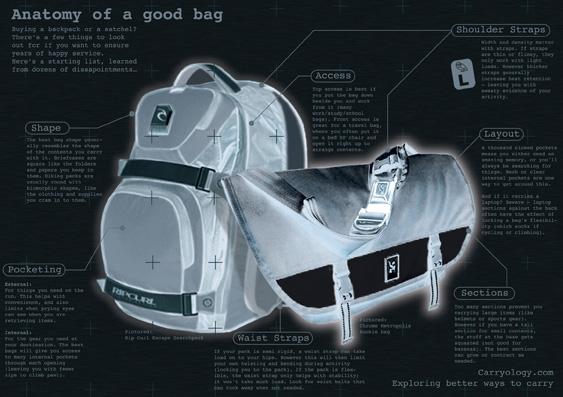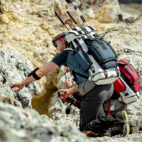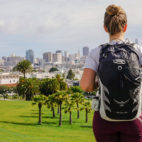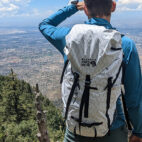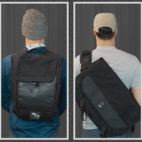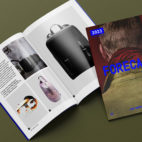Anatomy of a good bag
If you want the full sized version of the poster click [HERE]
Finding a bag you like the look of is probably your starting point, but there’s then a bunch of less obvious things that can make a huge difference to how much enjoyment you get from your backpack or messenger.
We’ve built this list through failure. Amongst the Carryology gang, we’ve probably owned, borrowed or used over 300 bags, and most of those went wrong in some way or another. We’re hoping this post will help you avoid some of those fails.
We expand on specifics after the jump…
—
Shape:
The best bag shape generally resembles the contents you carry with it. That means that briefcases are square like the folders and papers you keep in them. Or hiking packs are usually round with biomorphic shapes, like the clothing and supplies you cram in to them. If you bring a trekking optimised bag in to an office environment, it’s going to look out of place.
—
Pocketing:
External: External pockets best suit items you need on the run, things like sunglasses, tunes, food & books. This not only helps with convenience, it also limits what prying eyes can see when you are retrieving items.
Internal: If you’re reaching for an internal pocket, you really want to be at your destination, or have plenty of time and space, because you’ll need to open the bag up.
While lots of pockets are great for organising items, you don’t want to be opening 5 different zip pockets each time you arrive at your desk. A good trick is to have one zip or velcro flap open your access to several divided pockets. Yeah, that’s getting geeky.
—
Sections:
If you want to carry a helmet, a climbing rope, or a watermelon, you need a large main compartment. However if all you have are large compartments, you’ll find that your bananas tend towards a brown puree mush at the bottom of them.
The best sections can grow or contract as needed. Look out for neoprene gusseting or loose walls that allow this to happen. Good pocketing can also help avoid mashed bananas.
—
Layout:
If you’ve gone for a bag with loads of compartments and pockets, make sure they are reasonably transparent or intuitive (mesh or clear walls work well on internal pockets). If not, you’ll need a killer memory or a lot of time spent searching.
Pockets and sections for delicate things should always be high up, to avoid having items wedge against or atop of them.
And if your pack or messenger is built for a laptop, beware if it’s against the back panel. When you ride or skate, your back wants to bend, and that laptop is not going to.
—
Access:
Top access is best if you put the bag down beside you and work from it (many work/study/school bags). This lets you leave most items in the bag, and only retrieve them when needed (using the bag like a desk cabinet).
Front access is great for a travel bag, where you often put it on a bed or chair and open it right up to arrange contents. This is more like a suitcase opening.
—
Shoulder Straps:
Thick straps distribute load much better, spreading it across each shoulder (dense foam also helps do this). But these attributes tend to lock in the heat, leaving you with sweaty reminders of your activity.
Narrow straps and/or thin ventilated straps reduce the sweat issue, but will cut in and irritate with any major load carrying.
—
Waist Strap:
OK, we’re going to get really geeky here… lets make this fine print:
In trekking packs, waist belts are designed to take a significant proportion of the load and rest it directly on your hips. This works because the packs have a semi rigid frame, allowing the waist strap to ‘hold the pack up’. When this waist strap element is brought across to smaller day packs, their soft nature means the pack will just slump until the shoulder straps take up the weight again. So don’t expect much load bearing from a waist strap unless your pack has some rigidity.
Having said all that, a waist strap (and a sternum strap) can help improve stability, reducing the amount the pack can bounce around. The downside? By locking the pack to you, you also lock yourself to the pack, reducing your ability to bend and twist. We recommend them for larger day packs, but suggest finding ones that can tuck away when not needed.
—
Yep, so we’ve probably gone in to way too much detail there. But if you’re still with us, check out some of our other posts on our favourite versatile messengers and backpacks for some bags that tick most of these boxes.





 Carry Awards
Carry Awards Insights
Insights Liking
Liking Projects
Projects Interviews
Interviews
